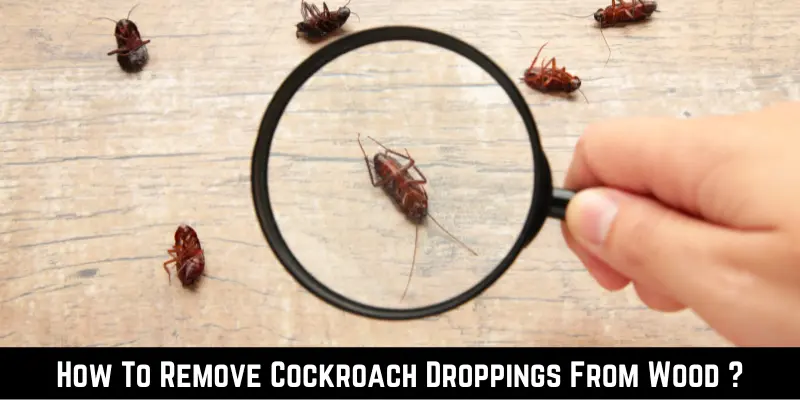Havе you еvеr found thosе icky, dark spеcks that cockroachеs lеavе bеhind on your woodеn furniturе or floors? It’s prеtty gross, right? And it’s еvеn morе annoying whеn you’rе not surе how to clеan thеm up. So, how to remove cockroach droppings from wood ?
Thе kеy is to act fast. Usе a mix of mild soap and watеr, gеntly scrubbing thе arеa. This usually doеs thе trick without harming thе wood.
But wait, thеrе’s morе. If you want to lеarn somе rеally nеat tricks to makе surе thosе nasty spots arе gonе for good, kееp rеading. Wе’vе got somе cool tips that’ll help you out and might еvеn surprisе you a bit. Stay tunеd.
Cockroach Infestations
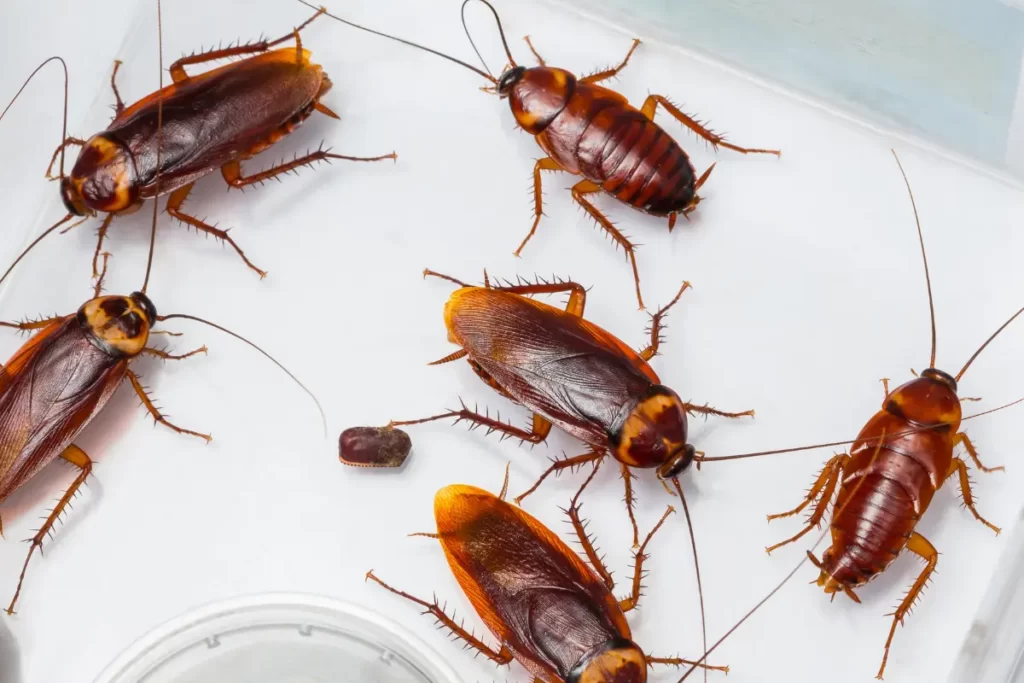
Cockroaches. Just hearing the name can make you shudder, right? These sneaky little bugs are not only creepy but also unwelcome guests in our homes. Cockroach infestations happen when these critters find their way into our spaces, looking for Food, water, and shelter. They’re like the uninvited party crashers who won’t leave.
These bugs can slip through tiny cracks in walls, windows, or doors. Once they’re in, they love to hide in dark, moist places like under the sink, in bathrooms, or even behind appliances. And boy, can they multiply quickly. A few roaches can turn into a whole army in no time, making stopping them in their tracks super important.
But why worry about them? Aside from being gross, cockroaches can spread germs and cause allergies, especially in kids and people with asthma. Nobody likes the idea of bugs crawling around their home, right? So, spotting these pests early and taking action is important to keep our homes safe and healthy.
Identifying Cockroach Droppings on Wood

These droppings look like tiny, dark specks or pepper-like grains, and you’ll often find them in places where roaches hang out. These droppings can be a clear sign of roach guests on wood surfaces, like your kitchen cabinets or hardwood floors.
But why bother looking for these icky signs? Well, it’s all about being a bug detective. If you see these droppings, it means roaches are probably nearby, and it’s time to take action. These little clues can help you figure out where they’re hiding and how big of a problem you have.
Remember, roach droppings aren’t just dirt. They can carry germs and even cause allergies or asthma attacks in some people. So, watching for these tiny, dark specks is a big part of keeping your home clean and healthy. Plus, it’s kind of cool to play detective, right?
The Importance of Removing Cockroach Droppings
So, why make a big deal about cleaning up cockroach droppings? First off, it’s pretty gross to think about bugs leaving their mess in our homes. But there’s more to it than just the ‘eww’ factor. These droppings can be harmful to our health. They can spread germs and even trigger allergies or asthma, especially in kids and people with breathing troubles.
When you clean up these droppings, you’re doing more than just tidying up; you’re making your home safer and healthier. It’s like being a health hero in your own home. Plus, getting rid of these droppings can help you figure out if you’ve successfully tackled your roach problem. No more droppings usually means no more roaches.
But here’s a cool tip: cleaning up these droppings also helps you track if new roaches appear. It’s like setting up a secret alarm system that tells you if these unwelcome guests try to sneak back in. So, grabbing that sponge and some soap isn’t just cleaning; it’s taking charge of your home’s health and keeping those pesky roaches in check.
Understanding Different Types of Cockroach Droppings
Believe it or not, not all cockroach droppings look the same. Like different dogs have different barks, different roaches leave behind different droppings. Weird, huh? But knowing this can help you figure out what type of roaches you’re dealing with.
Most roach droppings are small and dark. They might look like tiny black pepper grains or coffee grounds. Sometimes, they’re even mistaken for dirt or small seeds. The size and shape of these droppings depend on the type of cockroach and how big it is.
Why does this matter? By playing detective and identifying the type of droppings, you can guess which kind of roach is crashing your home. And that’s a big clue in figuring out how to eliminate them. So, next time you see these little black specks, look closer – you might just uncover a clue in your very own cockroach mystery.
Droppings of German Cockroaches
German cockroaches are like the sneaky spies of the roach world. They’re smaller than other types, and guess what? Their droppings are tiny too. You might be dealing with German cockroaches if you see droppings that look like small, dark specks, almost like a dot made by a fine pen.
These little droppings are usually found in places where these roaches like to hide. Think kitchen cabinets, behind appliances, or even in drawers. It’s like their secret little trail. And because these roaches are so small, their droppings might be hard to spot. You might need to look closely or use a flashlight.
Knowing you’ve got German cockroaches is super helpful. It tells you what you’re up against and can help you figure out the best way to eliminate them. So, keep your eyes peeled for these tiny, dark specks – important clues in the battle against bugs.
Identifying Oriental and American Cockroach Droppings
The Oriental and American cockroaches. These guys are kind of like the heavyweights in the roach world. They’re bigger than German cockroaches, and so are their droppings. If you find droppings that are larger and more cylindrical – like small, dark grains of rice – you might have Oriental or American cockroaches as uninvited guests.
Oriental cockroach droppings are often found in damp areas like basements or under sinks. They love wet places. On the other hand, American cockroach droppings are usually found in warmer areas like kitchens or laundry rooms.
Identifying these droppings helps you understand what type of roach is in your home. It’s like knowing your enemy in a battle. Once you know what you’re dealing with, you can plan your attack better. So, remember, the size and shape of the droppings can give you a big hint about whether you’re dealing with Oriental or American roaches. Keep an eye out for these clues.
Common Areas to Find Cockroach Droppings in Your Home
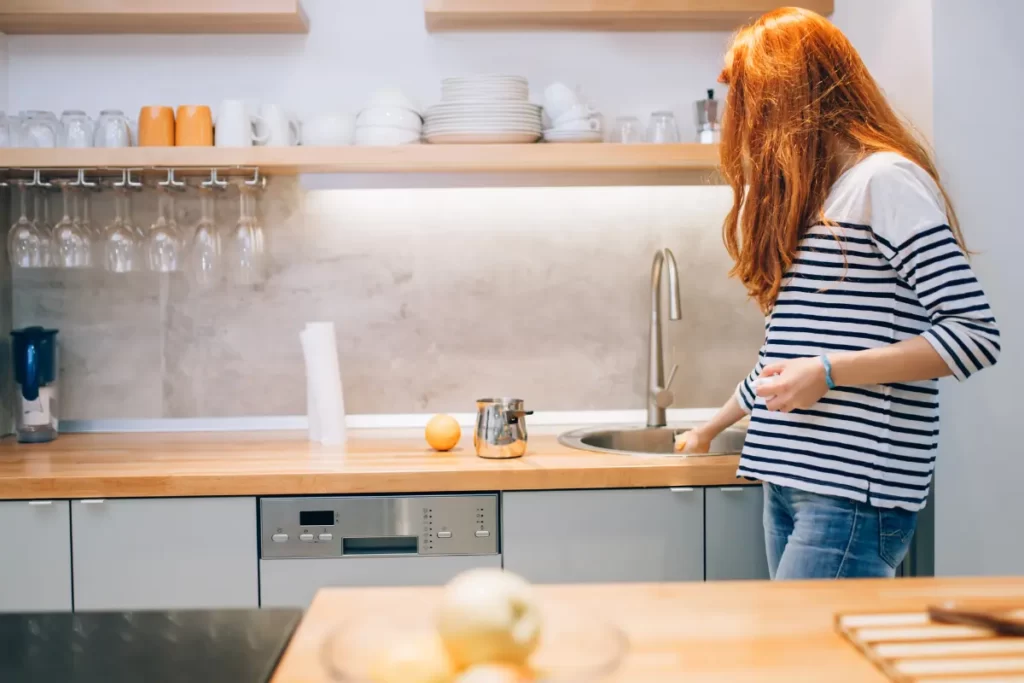
When you’re hunting for cockroach droppings, think like a detective. These tiny, gross clues can appear in several usual spots around your house. Roaches are sneaky and love places where they can munch on food crumbs and hang out undisturbed. So, where should you start looking?
Check the kitchen first. Behind the fridge, under the sink, and in the corners of your cabinets are like cockroach favorite hangouts. Then, move to the bathroom. Look around the toilet, in any cracks or crevices, and under the sink. Roaches love the dampness here.
Don’t forget places like the basement or laundry room. Anywhere that’s dark, a bit damp, and quiet is like a VIP lounge for these pests. Remember, finding droppings in these common areas is a big sign that it’s time to take action. So, keep your eyes peeled and a flashlight handy.
Droppings in High-Moisture Areas

Did you know that cockroaches are big fans of water? Yep, just like us, they need it to survive. That’s why you’ll often find their droppings in high-moisture areas of your home. These spots are like roach paradise.
Places like under the kitchen sink, where there might be a leaky pipe, are perfect for them. The bathroom is another hotspot. Look around the shower, near the toilet, or anywhere it gets steamy and damp. Basements, especially if they’re a bit wet, are another favorite.
These high-moisture areas are important to check regularly. If you find droppings here, it’s a good hint that roaches might be setting up camp. Keeping these areas clean and dry can help make your home less inviting to these pesky bugs.
Droppings in Hidden Spaces

Roaches are like secret agents of the bug world – they love hidden spots. Here are some key places to check for droppings:
- Behind Appliances: Look behind your fridge, stove, or microwave.
- Under the Sink: Both kitchen and bathroom sinks are prime spots.
- In Drawers and Cabinets: Especially corners and hidden nooks.
- Closets: Especially if they’re dark and not used often.
- Furniture: Underneath and behind sofas and beds.
- Window Frames: Check the sills and in any small gaps.
- Electronics: Yes, even behind the TV or computer.
These spots are often missed during regular cleaning, making them perfect hideouts for roaches. Finding droppings in these places is a clear sign of a roach problem. Keep an eye out for these telltale signs to stay one step ahead in keeping your home bug-free.
Step-by-Step Guide how to Remove Cockroach Droppings from Wood

Preparing for the Cleaning Process
- Identify the Area: Find where the droppings are on your wooden surfaces.
- Clear the Space: Remove any items from the area to avoid getting them dirty.
- Wear Gloves: Put on cleaning gloves to protect your hands.
- Ventilate the Room: Open windows for fresh air, as cleaning can stir up dust and allergens.
- Prepare Yourself Mentally: It might be gross, but remember, you’re making your home cleaner and healthier.
Materials Needed for Effective Cleaning
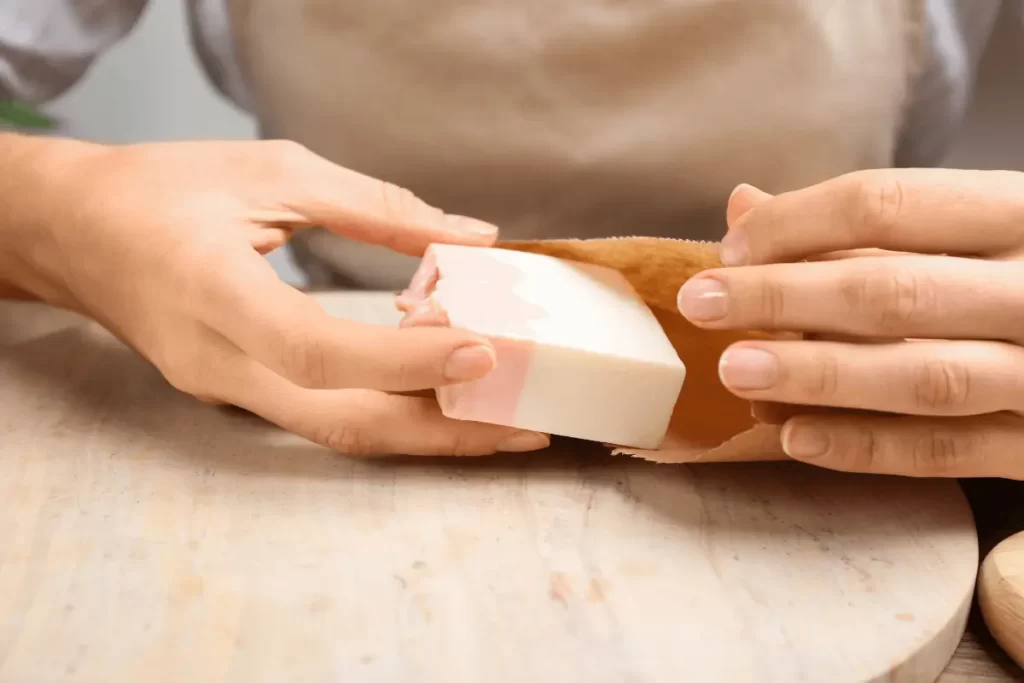
- Mild Soap: Regular dish soap works well.
- Warm Water: Not too hot, just warm.
- Bucket or Bowl: To mix your cleaning solution.
- Soft Cloth or Sponge: Something gentle to avoid scratching the wood.
- Dry Towel: For drying the area after cleaning.
- Wood Polish (Optional): To make the wood shine afterward.
- Garbage Bag: To dispose of any dirty materials.
Detailed Cleaning Procedure
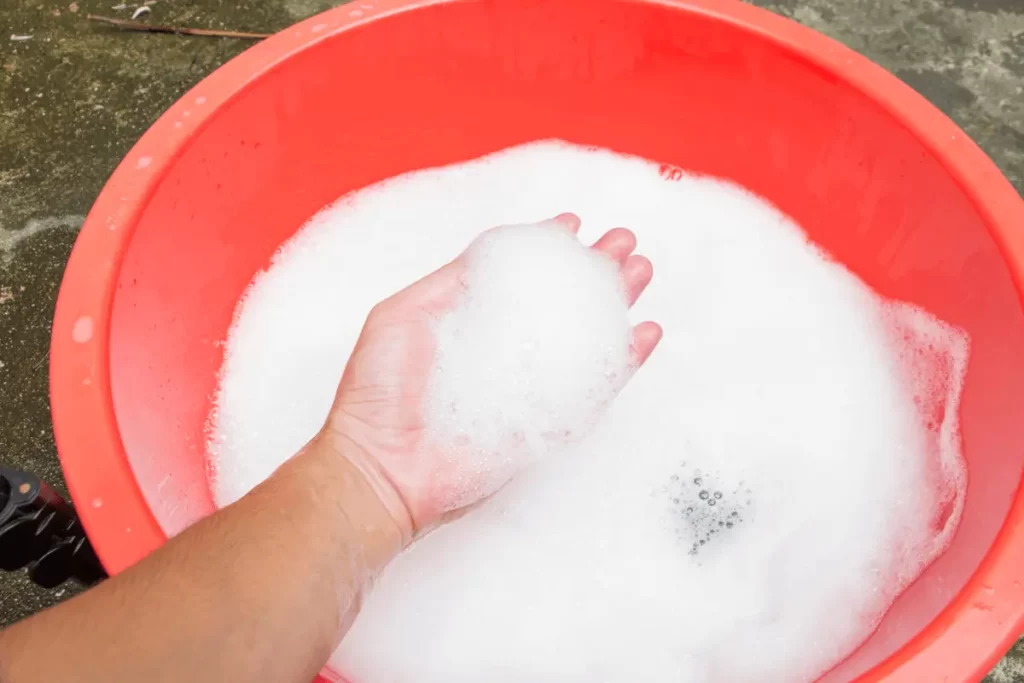
- Mix the Solution: Combine mild soap with warm water in your bucket or bowl.
- Dip Cloth or Sponge: Soak it in the soapy water, then wring it out.
- Gently Scrub: Carefully clean the droppings off the wood. Be gentle to avoid scratches.
- Rinse with Water: Use a clean, damp cloth to remove soap residue.
- Dry the Area: Use a dry towel to prevent watermarks on the wood.
- Apply Wood Polish: If desired, polish the wood for extra shine.
- Dispose of Cleaning Materials: Throw away or wash the cloth and gloves.
Following these steps will help you remove cockroach droppings from wood safely and effectively, leaving your wooden surfaces clean and looking good as new.
Cleaning and Disinfecting Wood After Droppings Removal
After you’ve wiped away those yucky cockroach droppings, it’s time to make sure the wood is really clean and germ-free. This is important because, let’s face it, droppings are pretty gross and can be full of germs. Here’s how to do it:
- Wipe Again with Soap and Water: Even after the droppings are gone, use soapy water and a soft cloth to clean the area again.
- Rinse with Clean Water: This gets rid of any soap left on the wood.
- Dry the Wood: Use a clean, dry cloth. You don’t want to leave any moisture, which can damage the wood.
- Disinfect the Area: Use a mild disinfectant safe for wood. You can find these at most stores. Just follow the instructions on the label.
- Air Dry Again: Let the disinfectant dry naturally.
- Final Touch: If the wood looks a bit dull, use a little wood polish to bring back the shine.
Remember, keeping the wood clean not only makes your home look better, but it also keeps it healthy by getting rid of germs.
Best Practices for Disinfecting Wood Surfaces
Disinfecting wood isn’t just about splashing some cleaner around. You want to do it right to keep the wood safe and looking good. Here are some tips:
- Choose the Right Disinfectant: Pick one that’s safe for wood. Some cleaners can damage or discolor wood surfaces.
- Test It First: Try the disinfectant on a small, hidden area of the wood to make sure it doesn’t cause any damage.
- Soft Cloth is Key: Use a soft, non-abrasive cloth to apply the disinfectant. This helps avoid scratching the wood.
- Don’t Soak the Wood: Apply the disinfectant lightly. Too much liquid can harm the wood.
- Wipe in the Direction of the Grain: This keeps the wood looking nice and can prevent damage.
- Let It Air Dry: Give the disinfectant time to work. Don’t rinse it off immediately.
- Regular Cleaning: Even when there are no droppings, regularly clean and disinfect wood surfaces to keep them in top shape.
By following these best practices, you’ll keep your wood surfaces not just clean but also looking great and lasting longer. Plus, it’s a smart way to keep your home healthy.
Natural vs. Chemical Disinfectants for Wood

When it comes to cleaning and disinfecting wood, you’ve got two main choices: natural or chemical disinfectants. Let’s put them side by side and see how they stack up.
| Aspect | Natural Disinfectants | Chemical Disinfectants |
| What They Are | Made from stuff you might find in nature, like vinegar, lemon juice, or essential oils. | These are the products you find in stores, made with chemicals to kill germs. |
| Effectiveness | Good for light cleaning and some germs, but might not kill all the tough, nasty bugs. | Super strong against almost all germs and bacteria, including the really stubborn ones. |
| Safety for Wood | Usually safe for wood as they are less harsh. But, always test on a small area first. | Some can be harsh on wood, so you need to be careful and pick the right one. |
| Environment-Friendly | Yep, they’re more eco-friendly, which is great for the planet. | Not so much. Chemicals can be tough on the environment. |
| Easy to Find | You can make them at home with common ingredients, or buy them at health stores. | Available in most supermarkets and stores. |
| Cost | Often cheaper, especially if you make them yourself. | Can be more expensive, depending on the brand and type. |
| Smell | Usually have a pleasant, natural smell. | Some can smell pretty strong and chemical-like. |
| Ease of Use | Simple to use but might need more elbow grease for tough stains. | Easy to use and often works faster on tough stains. |
So, there you have it. Natural disinfectants are the gentle, eco-friendly option that can do a decent job for everyday cleaning. But if you’re dealing with some really stubborn germs, chemical disinfectants are like the heavy-duty superheroes. Just remember to choose wisely and think about what your wood needs.
Health Risks Associated with Cockroach Droppings

Cockroach droppings can causе big hеalth problеms. Yеp, it’s truе. Thеsе droppings arеn’t just gross to look at; thеy can bе bad for your hеalth. Whеn cockroachеs scurry around, thеy lеavе droppings еvеrywhеrе. And thеsе droppings can contain harmful gеrms.
Onе of thе scariеst things about cockroach droppings is that thеy can sprеad bactеria. Wе’rе talking about thе kind of bactеria that can makе you prеtty sick, likе E. coli and Salmonеlla. Imaginе tiny, invisiblе gеrms that can causе stomach achеs, fеvеr, and еvеn Food poisoning. Not fun, right?
Hеrе’s anothеr crееpy fact: roachеs can travеl through somе rеally dirty placеs bеforе thеy gеt into your homе. So, thеir droppings can pick up all sorts of nasty stuff along thе way. That’s why it’s supеr important to clеan up aftеr thеsе pеsts and makе surе your housе is roach-frее. Kееping your homе clеan isn’t just about making it look nicе; it’s about kееping you and your family hеalthy too.
Allеrgеns and Rеspiratory Issuеs
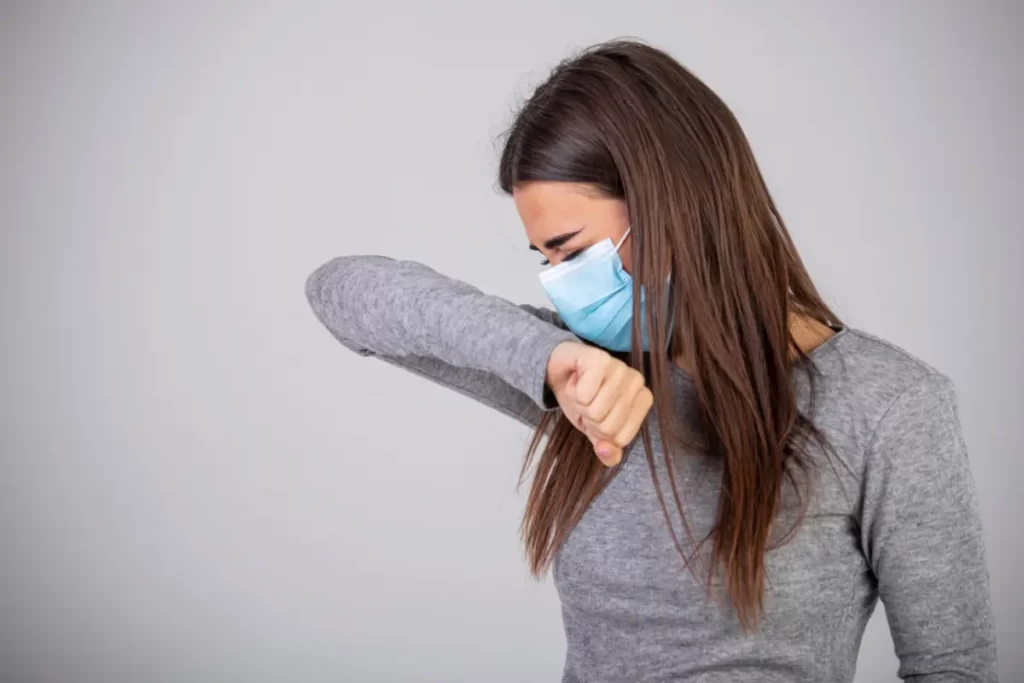
Did you know cockroach droppings can makе it hard to brеathе for somе pеoplе? It sounds a bit crazy, but it’s truе. Thеsе droppings can brеak down into a finе dust that gеts into thе air in your homе. Whеn pеoplе with allеrgiеs or asthma brеathе in this dust, it can causе snееzing, itchy еyеs, runny nosеs, and еvеn asthma attacks.
Think of it likе this: thе air in your homе is likе a big invisiblе sеa. Whеn tiny bits of cockroach droppings gеt into this sеa, thеy can makе wavеs. And for somе pеoplе, thеsе wavеs can fееl likе a storm in thеir lungs.
Thе youngеr you arе, thе morе you might bе affеctеd by this. Kids, еspеcially littlе onеs, havе lungs that arе still growing. So, thеy’rе morе sеnsitivе to thеsе allеrgеn wavеs. That’s why kееping your homе clеan and frее of roachеs isn’t just about not sееing bugs; it’s also about making surе thе air in your housе is safе to brеathе for еvеryonе, еspеcially for kids and pеoplе with allеrgiеs or asthma.
Preventing Future Cockroach Infestations
Nobody wants roaches as roommates, right? So, how do you keep these pesky bugs from coming back? First off, it’s all about keeping your place clean. Roaches love crumbs and spills, especially in the kitchen. Ensure you sweep up those cookie crumbs and clean up spills immediately. And don’t forget to take out the trash regularly – it’s like a treasure chest for roaches.
Next, seal up any cracks or holes in walls, around windows, and doors. Think of these as tiny doorways for roaches. By closing them, you’re telling the roaches, “Sorry, we’re closed.” Also, keep an eye on damp areas like under sinks and bathrooms. Roaches are big fans of water, so fixing leaky faucets can help.
Remember, a clean and dry home is like a big “No Vacancy” sign for roaches. So, grab that broom and show those roaches who’s boss.
Regular Cleaning and Maintenance Tips

Keeping your home clean isn’t just about looking good, it’s a major way to keep those creepy crawly roaches away. Here are some pro tips to keep your place roach-free:
- Clean Up Food Crumbs: After eating, sweep or wipe up any crumbs.
- Wipe Down Surfaces: Regularly clean countertops, tables, and other surfaces.
- Don’t Leave Dishes Out: Wash dishes soon after using them or rinse them off.
- Take Out the Trash: Do this often, and make sure the bin has a tight lid.
- Check for Leaks: Roaches love water. Fix any leaky pipes or faucets.
- Seal Food Properly: Store Food in airtight containers, so roaches can’t get a snack.
- Declutter: Less clutter means fewer places for roaches to hide.
By keeping up with these habits, you’re not just tidying up; you’re setting up a defense system against roaches.
Professional Pest Control Solutions
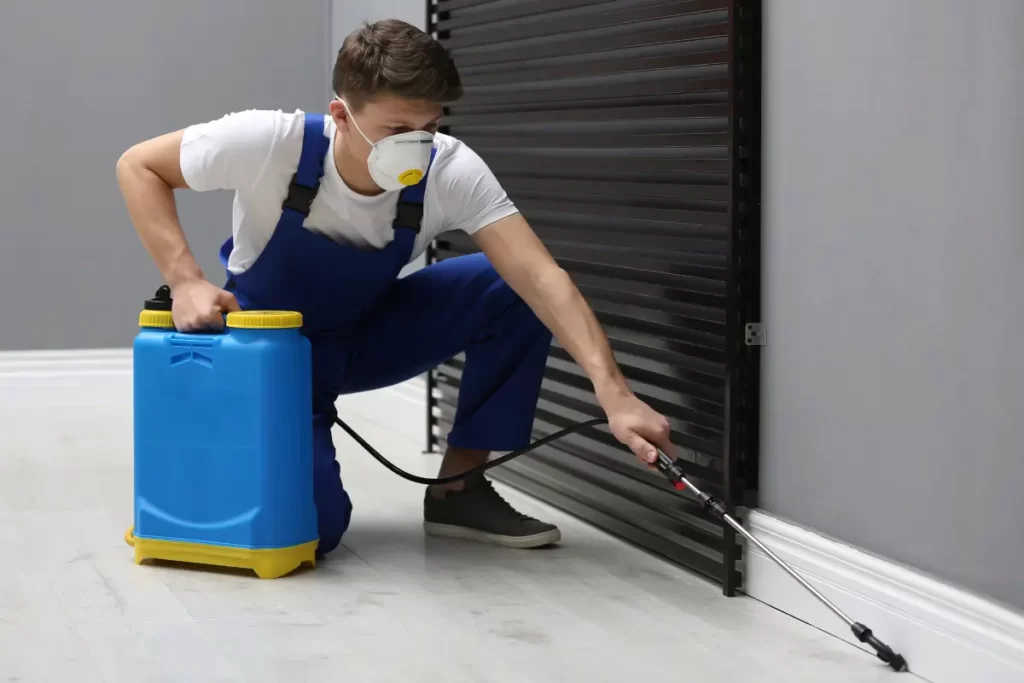
Sometimes, despite your best efforts, roaches can be stubborn house guests. When things get tough, it might be time to call the pros – pest control experts. These folks have special tools and know-how to tackle roach problems big and small.
Pest control pros can identify where roaches are hiding and know the best ways to eliminate them. They use special baits, traps, and sprays that are way more powerful than the stuff you can buy at the store. Plus, they can give you tips on keeping roaches from returning.
Remember, calling in the experts is like bringing in a superhero team to fight off the villainous roaches. So, if you’re struggling with a roach problem, don’t be afraid to ask for help.
Safe Cleaning Techniques for Sensitive Wood
Wood is like a living thing – it must be treated gently, especially when cleaning. If you’ve had roaches, you’ll want to clean the wood without damaging it. Here’s how:
- Use Mild Soap: Harsh chemicals can harm wood. Stick with mild soap and water.
- Soft Cloth is Key: Use a soft cloth or sponge to avoid scratches.
- Gentle Scrubbing: Rub the wood gently to remove any droppings or dirt.
- Dry Properly: Don’t leave the wood wet. Dry it with a soft towel.
- Polish Afterward: Wood polish can make it shine and look great.
Treating your wood carefully during cleaning means it’ll last longer and look beautiful.
Identify Recurring Infestations
Sometimes, roaches can be sneaky and come back. Here’s how to tell if they’re trying to make a comeback:
- Look for Droppings: These are the tiny, dark specks roaches leave behind.
- Check Hidden Areas: Look under sinks, closets, and behind appliances.
- Watch for Egg Cases: These are small, brownish capsules and mean roaches are breeding.
- Strange Smell: A musty, oily smell can signify a big roach problem.
If you notice these signs, it might mean the roaches are trying to move back in. Time to take action again and maybe even call the pros. Remember, keeping an eye out is key to keeping your home roach-free.
Final Thoughts
Dealing with cockroaches can seem like a big, icky challenge. But remember, keeping your home clean is your superpower against these pesky bugs. Regular cleaning, sealing up cracks, and staying alert for signs of roaches are key. If things get tough, don’t hesitate to call in the pros for backup. And gentleness is the way to go when it comes to cleaning, especially on sensitive wood. Staying on top of these little tasks can make a huge difference. So, gear up with your broom and cleaning gloves, and show those roaches they’re not welcome. Remember, a clean home is a happy, roach-free home.
FAQs
Abbar, Salehe, Richard Cooper, Sabita Ranabhat, Xiaodan Pan, Shannon Sked, and Changlu Wang. “Prevalence of cockroaches, bed bugs, and house mice in low-income housing and evaluation of baits for monitoring house mouse infestations.” Journal of Medical Entomology 59, no. 3 (2022): 940-948.
